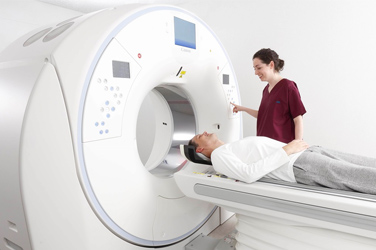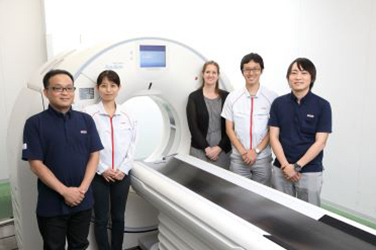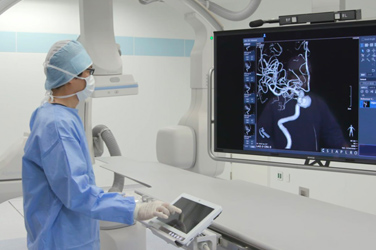

Examination Support with High-Definition Images and Advanced Automation Technology
X-ray CT System That Supports Emergency Medical Care
A Canon CT system incorporating advanced functions such as AI-based automation technology*1 plays a key role at Hakujyuji Hospital in Fukuoka City, Japan, which is a major regional healthcare center. We help improve efficiency at emergency medical facilities, which require immediate diagnosis while minimizing patient stress.
January 18, 2024
Fast Diagnostic Imaging in Emergency Medical Care
Anticipating expanding demand for emergency medical services, Hakujyuji Hospital decided to install a new computed tomography (CT) system when they moved to their new hospital building. They selected a CT system manufactured by Canon Medical Systems Corporation.
CT systems, which use X-rays to visualize structures inside the body, are essential for the diagnosis and treatment of emergency patients.
In April 2021, Hakujyuji Hospital installed Canon Medical's flagship model, a 320-row area detector CT system featuring an image acquisition range of 160 mm per rotation for imaging a wide range in a short scan time. The system is used by the emergency department as well as a variety of other clinical departments and has been highly appreciated by physicians and radiologic technologists. Since relocating to their new building, the hospital has been treating about 4000 emergency patients per year and performing more than 50 CT examinations per day. Therefore, in February 2022, they decided to also install a compact 80-row multislice CT system supporting high-speed scanning.

Established in 1982 in Fukuoka City, Japan, Hakujyuji Hospital is a core regional hospital dedicated to providing community health services.

Dr. Yasuhide Fuchino
Director of Hakujyuji Hospital
"As a regional hospital,*2 we have a solid system in place focusing on emergency medical care, which is in great demand."
Dr. Yasuhide Fuchino, Director of Hakujyuji Hospital, explains their reasons for selecting an 80-row CT system manufactured by Canon Medical Systems Corporation.
"The system can quickly scan the entire body and provide high-definition images comparable to those obtained using our current 320-row area detector CT system. In addition, it features functions incorporating AI-based automation technology*1 which are expected to improve examination efficiency."
The 80-row CT system is installed in the Advanced Imaging Center of the Department of Radiology adjacent to the Emergency Center, allowing emergency patients to undergo CT examinations without delay. Now that the system has been in operation for one year, hospital director Fuchino summarizes his impressions as follows.
"The system has fully met our expectations by providing advanced and rapid diagnostic imaging for emergency medical care. Especially during the COVID-19 pandemic, it shortened patient waiting times and was helpful in reducing the risk of infection."
Positioning images can be used to start emergency treatment without delay.
In conventional CT scanning, a positioning image is acquired to check the scan range before performing the actual scan. The scan range is set based on the positioning image, and the actual scan is then performed to examine the target region. However, depending on the experience and skill of the radiologic technologist, repeat scanning may sometimes be necessary due to problems such as insufficient coverage and so on. Mr. Hiroyuki Yamaguchi, a radiologic technologist at Hakujyuji Hospital, explains that the 80-row CT system has a function that acquires images as 3D data in the initial positioning scan and automatically determines the scan range, leading to much shorter examination times.

Mr. Hiroyuki Yamaguchi
Radiologic technologist in the Department of Radiology of Hakujyuji Hospital
Mr. Yamaguchi points out another important advantage. Because the positioning scan provides cross-sectional images, it is possible to start preparations for treatment even before performing the actual scan.
"For example, when we perform a positioning scan for a patient with arm numbness, we can use the head images acquired in the positioning scan to see whether the patient's symptoms are due to cerebral hemorrhage or infarction. In cases requiring immediate intervention, such as patients with acute cerebrovascular events, we can start treatment planning based on the diagnostic information obtained by the positioning scan."
We can quickly identify the suspected problem and take appropriate actions in emergency patients, improving efficiency in emergency medical care.

Images are acquired as 3D data by low-dose scanning.
The scan range is automatically determined by analyzing the images using AI technology*1.
Rapid preparation for emergency scanning without the need to reposition the patient
According to Mr. Yamaguchi, their workflow after the patient enters the CT room has changed dramatically since the introduction of the 80-row CT system. Previously, after the patient was placed on the CT couch, in addition to operating the buttons on the system itself, it was often necessary to physically reposition the patient to the scan start position. With the new 80-row CT system, the patient position is automatically determined using two cameras built into the gantry. Mr. Yamaguchi is impressed that this AI-based technology*1 allows the operator to simply press the couch movement button on the touch panel. The CT system automatically determines the patient position and quickly moves the couch to the scan start position, eliminating the need to physically reposition the patient.

The positions of a patient's joints etc. are determined based on images acquired by two Canon cameras and an advanced position identification model designed using deep learning.*1
"Eliminating the need to reposition the patient is a great benefit not only for medical staff but also for the patient. In addition, because the patient couch can be moved laterally,*3 the time required for positioning emergency patients is significantly reduced."
CT systems that are designed for patient comfort
The size and design of CT systems are also important because these large medical devices can be intimidating or frightening to patients. Mr. Yamaguchi notes that their 80-row CT system is quite compact and has a large gantry aperture of 800 mm, so patients feel more relaxed and comfortable during examinations.

"The wide examination space reduces the sense of claustrophobia that some patients may feel during examinations, and many of our patients have commented on the pleasant and friendly design of the system, which I think helps them feel more relaxed and comfortable. In addition, even patients who need to be scanned with the elbows positioned away from the body, which is common for emergency patients, can be examined with greater safety because there's less risk of interference with the system.
Furthermore, strict infection control measures were instituted during the COVID-19 pandemic, and the thorough disinfection of medical equipment became an even more important issue. Cleaning conventionally designed systems after examinations can be difficult and time-consuming.
"Our 80-row CT system has a flat and smooth touch panel that's very easy to clean. This not only reduces patient waiting times but also ensures a safer examination environment."
The risks associated with X-ray exposure during medical procedures is another important concern for both patients and healthcare professionals. The 80-row CT system supports low-dose examinations thanks to the use of a special X-ray filter containing silver and advanced image processing technology developed using deep learning*1 to achieve high-quality imaging at low radiation dose. Hakujyuji Hospital is certified by the Japan Association of Radiological Technologists as a facility that promotes the reduction of medical radiation exposure. The hospital continuously monitors radiation doses to ensure that patients undergo radiological procedures with the highest level of safety.
Simple operation makes it easy to learn how to use the system.
It takes time to learn how to operate a CT system, but Mr. Yamaguchi notes that young radiologic technologists can easily learn to use their system after just a brief introduction.
"The CT interface has been completely redesigned and is simple and easy to use. I was really surprised by how quickly young radiologic technologists, who could be called "smartphone natives", can learn to operate the system, probably thanks to its intuitive operation. I think it's essential to design systems that can easily be used by young people, who will become the next generation of healthcare professionals."
After scanning is complete, the operator simply selects the data, and the images are displayed in a preset layout according to the target region and exam type. This helps to improve efficiency in image interpretation.
"In addition to being able to view images on a large 27-inch screen, cross-sectional images and 3D images suitable for the type of exam and target region can be checked as soon as scanning is completed. When immediate action is required, as is often the case in emergency care, treatment can be started without having to wait for the radiologic technologist to process the images."

Select the data of the image to be evaluated.

Images are automatically displayed in preset layouts.
Future expectations for technological advances to support healthcare
Dr. Fuchino states, "Hakujyuji Hospital has high expectations for Canon Medical's CT technology in helping us move forward as a regional medical care support hospital." He also shares his thoughts on the future of the healthcare community.
"With the current emphasis on digital transformation in the field of healthcare, we hope that Canon's advanced technologies will play an important role as the healthcare community moves into the future. I'm particularly looking forward to the development of products that can easily be used by young people, who will be the next generation in the future of healthcare, as well as to the development of advanced technologies that can help us fight against new infectious diseases that will emerge in the future."
Canon is committed to ensuring patient safety and comfort and to developing advanced technologies to support healthcare professionals.
- *1: AI technology is used in the design stage of the system. The system itself does not have self-learning capabilities.
- *2: These are medical facilities approved by the prefectural governor which fulfill the following four roles and functions: (1) providing medical care to referral patients (including reverse referrals to primary care physicians), (2) providing medical equipment for shared use, (3) providing emergency medical care, and (4) providing training for local medical professionals.
- *3: This function is optional.





